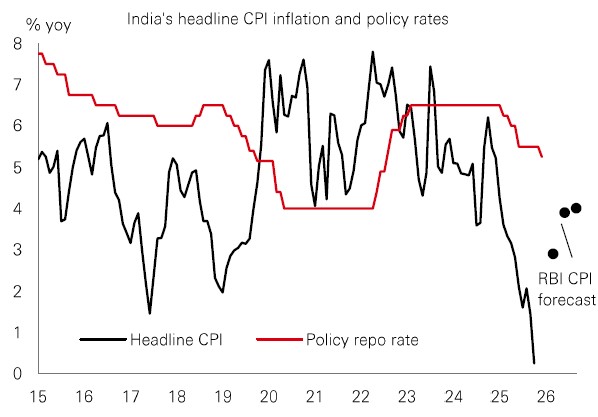
15 December 2025

For the first two decades of the 2000s, the performance of stocks and bonds was negatively correlated. So, when stocks underperformed, bonds tended to do better. That dependability helped to shape thinking on ways of achieving an optimal portfolio mix – including the 60/40 stocks/bonds allocation – with bonds providing ballast and diversification.
But that correlation has flipped to positive in the post-pandemic era, driven by inflation volatility and policy uncertainty. While last week’s Fed rate cut was a move to insulate the labour market (see page 2), with growth holding up, policies being supportive, and supply shocks in the mix, we could see faster cyclical inflation in 2026, and that points to potentially sticky long bond yields. Because of this, the traditional role of bonds as a diversifier could continue to prove less reliable, leaving investors to reconsider old assumptions and sparking a search for “bond substitutes” as a source of diversification and portfolio resilience.
It means that liquid alternatives are back in focus – and that includes hedge funds. In the post-GFC era, hedge funds weren’t particularly in demand from investors, given that traditional bonds were an effective hedge. But today’s environment is more similar to the 1990s, when inflation was stickier, the world was more fragmented, central banks’ role a bit more limited, and fiscal policy more active. It means that expected return profiles across macro, credit, and trend-following hedge fund strategies show a potentially compelling diversification premium.
With the stock/bond correlation potentially remaining positive in this new, higher-inflation environment, “bond substitutes” in the form of hedge funds – as well as other alternative asset classes – can offer a way to “diversify the diversifiers”.
Huge capex spending on AI infrastructure has been a major investment theme this year. The current build-out is the first of what’s expected to be a three-phase cycle that will see a shift to more firms using AI software, and then broad adoption and monetisation. Yet, uncertainties still persist over future returns and the risks of over-investment.
Current capex spending has been focused on semiconductors, data centres, and power infrastructure. Hyperscalers are projected to spend nearly USD400 billion this year. But the scale of commitments through 2028 – projected at close to USD3 trillion – is gradually shifting the funding dynamics for these major firms. Declining free cash flow has led to more reliance on external financing, with bond issuance estimated at around USD200 billion through the period.
For now, the hyperscalers have strong credit fundamentals, manageable debt and robust free cash flow. So, the present backdrop has better debt characteristics than the dotcom bubble and the GFC. But given the scale of funding needed, the complexities of adoption, high expectations, and the potential for overcapacity in AI infrastructure, risks will need to be monitored carefully in the coming years.
The value of investments and any income from them can go down as well as up and investors may not get back the amount originally invested. Past performance does not predict future returns. The level of yield is not guaranteed and may rise or fall in the future. For informational purposes only and should not be construed as a recommendation to invest in the specific country, product, strategy, sector, or security. Diversification does not ensure a profit or protect against loss. Any views expressed were held at the time of preparation and are subject to change without notice. Any forecast, projection or target where provided is indicative only and is not guaranteed in any way. Source: HSBC Asset Management, Bloomberg, Macrobond. Data as at 7.30am UK time 12 December 2025.
The Fed has delivered a widely expected 0.25% rate cut. But two members dissented in favour of unchanged policy, and the ‘dot plot’ signalled four non-voters also preferred no change. Stephen Miran voted for a 0.50% cut. Chair Powell said the policy rate is now within a “plausible range” of neutral with the Fed “well positioned” to see how the economy evolves. While the FOMC still sees inflation risks as tilted to the upside and its base case is solid growth and broadly stable unemployment next year, the bulk of the committee is concerned about labour market risks. Chair Powell revealed the Fed thinks that payrolls growth is being overstated by around 60k per month, meaning employment has fallen by an average of 20k per month since May, rather than rising at the published near-40k pace. Powell noted this situation requires watching “very carefully”. Investors need to do the same. |
A modestly pro-risk stance, including EM equities and bonds where valuations still offer some cushion, may help hedge against disappointing macro news.

However, the cut was delivered against the backdrop of a weakening trend in the rupee. With the RBI having now delivered a cumulative 1.25% of cuts, the actions of the Fed in 2026 look more important as a constraint to further significant policy action.

The South African rand has moved to its strongest levels since early 2023, breaching the ZAR17.0 level versus the US dollar.
Key to this is the country’s improving fiscal position, with its deficit now back to the pre-Covid average. The Q3 current account deficit also came in smaller than expected. This is significant given that South Africa was previously labelled a "fragile-five" economy – with fiscal weakness making it vulnerable to capital flight. Indeed, the five-year average of its current account balance now shows a surplus, and its terms-of-trade have soared during the second half of this year.
The South African Reserve Bank recently adopted a more stringent 3% inflation target from the previous range of 3-6%. This could allow the country to lock in lower interest rates over time, and be growth positive. In a year when many emerging markets have been ”lucky” because of weakness in the US dollar, South Africa is further evidence that EMs have also been “good”. Macro reforms and more developed financial markets have derisked many EMs – making these markets less volatile than many developed markets.

Past performance does not predict future returns. The level of yield is not guaranteed and may rise or fall in the future. For informational purposes only and should not be construed as a recommendation to invest in the specific country, product, strategy, sector, or security. Diversification does not ensure a profit or protect against loss. Any views expressed were held at the time of preparation and are subject to change without notice. Index returns assume reinvestment of all distributions and do not reflect fees or expenses. You cannot invest directly in an index. Any forecast, projection or target where provided is indicative only and is not guaranteed in any way. Costs may vary with fluctuations in the exchange rate. Source: HSBC Asset Management. Macrobond, Bloomberg. Data as at 7.30am UK time 12 December 2025.


Source: HSBC Asset Management. Data as at 7.30am UK time 12 December 2025. For informational purposes only and should not be construed as a recommendation to invest in the specific country, product, strategy, sector or security. Any views expressed were held at the time of preparation and are subject to change without notice. Any forecast, projection or target where provided is indicative only and is not guaranteed in any way.
Risk markets firmed following the Federal Reserve’s latest 0.25% rate cut, with the US dollar slipping against major currencies. Fed Chair Powell stated that the FOMC is “well positioned to wait and see how the economy evolves”. Front-dated US Treasuries rose as the Fed started the reserve management purchase operations, while long-end US Treasury yields moved sideways ahead of upcoming employment and CPI inflation data. Meanwhile, hawkish comments from ECB member Schnabel weighed on longer-dated German bunds. US equities posted broad-based gains, led by the Russell 2000, although tech stocks experienced volatility. The Euro Stoxx 50 also advanced, and Japan’s Nikkei 225 edged higher ahead of this week’s BoJ meeting. In EM Asia, indices in China and India were on course to close last week modestly lower. Elsewhere, oil prices declined, while gold price strengthened.





We’re not trying to sell you any products or services, we’re just sharing information. This information isn’t tailored for you. It’s important you consider a range of factors when making investment decisions, and if you need help, speak to a financial adviser.
As with all investments, historical data shouldn’t be taken as an indication of future performance. We can’t be held responsible for any financial decisions you make because of this information. Investing comes with risks, and there’s a chance you might not get back as much as you put in.
This document provides you with information about markets or economic events. We use publicly available information, which we believe is reliable but we haven’t verified the information so we can’t guarantee its accuracy.
This document belongs to HSBC. You shouldn’t copy, store or share any information in it unless you have written permission from us.
We’ll never share this document in a country where it’s illegal.
This document is prepared by, or on behalf of, HSBC UK Bank Plc, which is owned by HSBC Holdings plc. HSBC’s corporate address is 1 Centenary Square, Birmingham BI IHQ United Kingdom. HSBC UK is governed by the laws of England and Wales. We’re authorised by the Prudential Regulation Authority (PRA) and regulated by the Financial Conduct Authority (FCA) and the PRA. Our firm reference number is 765112 and our company registration number is 9928412.